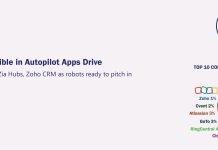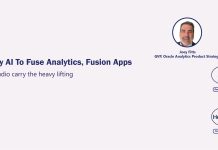
The convergence of autonomous software, artificial intelligence and machine learning applications is driving corporate spending, ushering a wave of digital transformation initiatives that could reshape the enterprise IT marketplace for decades to come.
For anyone trying to quantify the vast opportunity made possible by autonomous database, AI-based decision-making and ML algorithms, consider these examples:
- Drop Tank, a US developer that serves a growing base of more than 3,500 fuel and convenience stores, is using Oracle Autonomous Data Warehouse to power a loyalty and rewards system that automatically drops the price of gasoline for members, while simultaneously capturing, analyzing and managing the data collection process in order to unlock customer insights on behalf of suppliers like Marathon Oil.
- Hong Leong Bank Berhad, a top financial institution in Malaysia, is running HALI, a virtual assistant developed by Hyperlab, to automate human resources and retail banking functions, thusly eliminating time-consuming and routine tasks like staff queries on HR policies and procedures as the bank expects the use of the new chatbot to improve both inhouse and branch operations efficiency by 60% over the course of the year.
- As part of a three-year digital transformation initiative, Australia’s Office of State Revenue in Queensland is expanding the use of a machine learning algorithm following a successful SAP Leonardo trial project that has already helped the tax agency reduce land tax debts by 5%, while improving collection and compliance among 97,000 taxpayers on the heels of an eight-week analytics run that covered more than 187 million data records over a seven-year period.
These examples form the basis of our upcoming Digital First 500 special report in which hundreds of these digital transformation initiatives and use cases will be presented to our subscribers throughout 2018 and beyond, all highlighting the spreading of the latest enterprise applications by companies large and small to influence and reshape their industries, countries and people’s behavior – culminating in greater business value for everyone.
Autonomous Software, AI and ML Play A Key Role
The growing popularity of autonomous software, artificial intelligence, and machine learning offerings and implementations is expected to reinvent the enterprise IT marketplace, raising the possibility that these emerging technologies will drive incremental gains to the overall IT spend or at least offset any erosion left behind by existing solutions that are losing ground.
Similar to any technology paradigm shift in the past, vendors are jumping onto the Autonomous, AI and ML bandwagon in order to breathe new life into the enterprise software market, which has been buffeted by a surge in Cloud implementations often at the expense of onpremise solutions resulting in anemic organic growth for many well-established vendors.
Unlike the previous moves from Mainframe to Client Server Computing, PC to Networking, or mobile phone to Smart Device, the transition from generic reporting or off-the-shelf analytics to deep-learning and self-running software faces a host of thorny issues. These include reskilling and upskilling current and future employees with AI-based robots increasingly taking over both routine and sophisticated tasks, faulty algorithms providing poor decisions and recommendations, and ultimately businesses facing increased risks when human intervention is removed from certain processes like auditing.
AI supporters consider these concerns overblown, given the fact that most of us are paying scant attention to the risks of traveling by air (with the bulk of the flight time taken over by auto-pilot), consuming manufactured foods from ice cream to chocolate (with most of the production steps being done by machine), and indulging in daily activities from streaming music to gaming(all made possible without any human intervention).
Opponents are alarmed by the prospects of progressing from machine-made products and services to contactless relationships such as riding a bus without a driver, doing physical checkup without a doctor, or even completing K-12 education without a teacher, all of which could be rendered by present and future software algorithms and robots.
On the upside, a society run by autonomous technology can still manage to keep societal order in place, while continuously redefining the job marketplace through reskilling and upskilling. To wit, Japan has been helped by extensive use of vending machines in retailing and robots in manufacturing to ease perennial shortages of workers due to demographic shifts. Since the industrial revolution, the job marketplace has always been a state of flux. One needs to look no further than the many job openings at construction firms for solar equipment operators, a position that did not even exist a decade ago. The rise of AI, ML and other advanced technologies will create new jobs from drone operators to robot maintenance leaders, while redefining existing ones from drivers to safety specialists.
Notwithstanding such concerns and prospects, the market is going to be huge for autonomous software, AI and ML solutions, collectively in what we call a new breed of applications that mimic Management In Auto Pilot (MAP). See our definition of such MAP applications below.
Our projection is based on the following modeling and assumptions:
Current run-rate of the enterprise application market, which tops $220 billion annually mostly in license, maintenance and subscription revenues and growing anywhere between 1% and 3% through 2030. By 2030, the enterprise applications market could reach $287 billion.
By 2030, another $128 billion will be spent on Infrastructure and Platform As A Service – covering a range of database, integration, identity management, system management, encryption, compute and storage software technologies.
That results in as much as $415 billion of software spend by 2030 and our estimate is a quarter of that, or up to $105 billion, will ship with Autonomous Software, AI and ML capabilities through the end of the forecast period.
Why a quarter? Here’s our math based on months of research on product roadmaps of ISVs, spending patterns of end users, and investment plans of institutional investors.
ISVs Drive Autonomous Movement
In our regular surveys of ISVs, vendors are gearing up for digital transformation projects that are becoming the norm among their customers, many of whom are demanding better use and value of operational and customer data that they have been aggregating for years.
Adding a new database engine is becoming the prerequisite for such digital transformation initiatives. In August 2018, we surveyed 42 ISVs including some of the biggest names in the software industry and 60% of respondents said it is very important to expand their database options for their customers‘ digital transformation projects, as shown in Exhibit 1 below. Thirty-one percent of the respondents said it is very important to add a new database in their replatforming strategy, the same survey finds.
Exhibit 1 – ISVs Are Expanding Database Options

Our projection calls for up to half of existing database systems will be upgraded or replaced over the next seven to 10 years because of the proliferation of different data types, increased demand for database and analytics bundled together, as well as growing popularity of autonomous capabilities for patching, tuning and data encryption to reduce IT costs and optimize performance. These trends will favor vendors such as Oracle, which is on the vanguard of the autonomous movement that builds on top of its leading market share in the $40-billion+ database market. That is going to translate into at least $20 billion spend on new databases, many of which will sport autonomous capabilities.
Additionally, our model suggests at least $140 billion will be spent on Cloud applications by 2030. Again, half of that will feature some Autonomous Software, AI and ML capabilities, resulting in about $70 billion for those advanced products through the forecast period. For this exercise, we primarily focus on Cloud applications that will be the primary vehicle for delivering autonomous, AI and ML functionality because the majority of ISVs in our survey rank Cloud and Hybrid Cloud as their preferred modes of making their products available to their customers.
The good news is that best of breed vendors for AI will coexist with suite providers that span the full spectrum of Autonomous, AI and ML products, potentially driving growth further for both sides. For example, Blue Prism, which specializes in robotic process automation applications to create a virtual workforce, is capable of automating processes like corporate payments and complex transactions that involve counterparties and regulatory compliance. The UK-listed Blue Prism reached 700 customers by April 2018, compared with 41 three years earlier. Its half-year revenues jumped to $35 million in April 2018, up 133% from $15 million a year ago. Already, Blue Prism has signed up a number of platform partners like Microsoft to help each other expand in the AI market.
Similarly, the extensive use of AI technologies will spur additional use of new databases. Hong Leong Bank, the Malaysia financial institution that started running a chatbot this year, is also a major customer of Oracle database and Exadata engineered systems running them across different affiliates of Hong Leong Group, a conglomerate that operates in manufacturing, hospitality and financial services sectors. As Hong Leong Bank extends use of the chatbot to other functions, the greater demand it finds itself for autonomous database capability from its platform provider.
Customers Cover Their AI Bases
By 2030, our forecast shows that another $15 billion will be spent by customers primarily those using different Autonomous Software, AI and ML tools for internal development.
If digital transformation is the banner customers find themselves operating under these days, the need to use innovative tools like AI to harvest and harness the data is the rallying cry. Autonomous, AI or ML use cases designed for Collaboration, CRM, HR and Supply Chain are multiplying.
At a recent BoxWorks conference with 9,000 registrants, next-generation content management and collaboration applications based on AI and ML technologies were among the main topics of discussion. The enterprise architect at Rodan + Fields, a $1.5-billion cosmetic company that sells its skin care products through 300,000 independent consultants(Avon style), expects to spend $6 million in 2018 on such AI-driven projects to better understand the behavior of its army of independent consultants and how they serve millions of consumers mostly via social media interactions.
Elsewhere, Sany, a heavy equipment maker in China, is tracking its 380,000 Internet-connected concrete mixers, excavators and cranes and it has collected more than 100 billion data points on their running conditions, according to an article in the August 27, 2018 issue of Wall Street Journal.
Both cases suggest that companies are investing millions of dollars on cutting-edge AI projects. The tsunami effects of other companies following Rodan + Fields and Sany to plan, analyze and execute on their AI software strategies will help put the $15 billion target within reach in the next 10 to 15 years, as shown in Exhibits 2 and 3 below.
Exhibit 2 – Sizing Autonomous, AI, ML Software Market, Graphic

Exhibit 3 – Sizing Autonomous, AI, ML Software Market, $M, Table
| 2018 | 2024 | 2030 | |
|---|---|---|---|
| New Databases That Are Autonomous | 10 | 5000 | 20000 |
| Cloud Apps That Incorporate AI and ML | 75 | 16800 | 70000 |
| Other Autonomous Software, AI and ML Tools | 15 | 8500 | 15000 |
| Total | 100 | 30300 | 105000 |
Source: Apps Run The World, September 2018
Investors Chip In The Rest
Ignoring all the hype about Autonomous Software, AI and ML, one can still appreciate the magnitude of the market opportunity by simply tabulating billions of dollars that large and small investors have poured into the space over the past few years. Since 2017, Toyota has raised a $100 million fund on AI. Heavy hitters from Andreessen Horowitz to Softbank are doing the same with millions of dollars earmarked for AI investments.
Currently there are hundreds – if not thousands – of startups being created to leverage the latest machine learning technologies, fitting them in for specific verticals and use cases. In Israel alone, there are more than 430 startups using AI as a core part of their offering, according to a 2017 post in Medium.
Our estimate is that successful startups will find the biggest traction in areas that for years have been left untouched. For example, daily records like invoices, activities like public transit, and transactions like commodity trading will be the focal point of a new generation of ML applications that aim to unearth new insights from massive amounts of data.
The question is whether search engine, one of the most significant symbols of the Internet age, will be usurped by Autonomous Software, AI and ML because the search function will be done mostly in the background. By the same token, the rise of autonomous vehicles will relegate navigation tools to a minor role. Instead, the self-decisioning process will become the default solution as a flood of Management in Auto Pilot applications take center stage driving different business processes on behalf of key stakeholders.
Implications of Explosive Market Growth
The explosive growth of Autonomous, AI and ML use cases in the coming years will have enormous implications for vendors, customers and the society at large. Here are a few worth contemplating:
- Emergence of a brand new ecosystem made up of different Autonomous, AI and ML players, all seeking to drive the biggest synergistic growth for all the parties involved. The driving force will be most apparent across adjacent verticals. For example, a builder will use AI to predict how many nursing homes or beds will be needed and whether it’s lucrative to become a care operator as well. Software vendors involved in healthcare and construction verticals will band together to generate those insights.
- Mass personalization will become a reality judging from the growing popularity of customized sneakers from the likes of Adidas and Nike. Margins on such highly configurable products will be heftier and real-time supply chain management could squeeze costs further. Still, speed of getting these products to buyers is of the essence.
- The reliance on Autonomous, AI and ML software will favor bigger companies with plenty of big data to mine, but can they deliver truly exceptional support and customer experience simply by doing well in the data game?
For the society at large, at a time when many companies are ceding certain businesses like books and hard-to-find items to eCommerce, short hauls to ride-sharing apps and even investment advices to robots, what they need is to figure out how to master the treasure trove of their operational and customer data in order to prevail in a market segment they can still win.
The rise of smartphone has not killed personal computers because the latter simply adapt to changing usage patterns (focusing on purpose-built laptops for gaming, point-of-sale terminals or simply demo stations). The same applies to the growing popularity of AI, which will create a new class of jobs after rendering some obsolete. The companies that stand a good chance winning the Autonomous, AI and ML race will be those capable of leveraging smart data and insights to segment the market to the granular level that awards them with the most profitable customers.
Bigger companies are likely to have an advantage over smaller ones in the AI game because the former have more data to play with. However, the minute a company figures out it’s no longer profitable to cater to a market segment based on the recommendation from an AI engine, someone else would try to upend that segment by exploiting the vacuum.
That’s why our forecast is showing Autonomous Software, AI and ML will account for a quarter of the market through 2030, the rest may rest on human ingenuity and other factors like cultural differences that even the smartest AI engine fails to comprehend.
Definition of Management In Auto Pilot (MAP) Applications
Autonomous software, AI and ML capabilities will manifest themselves in what we call MAP applications. What defines this group of Autonomous Software, AI and ML technologies is the self-running, self-populating, and self-learning aspects of these MAP products.
Self-running is easy to define as in self-driving vehicle guided by satellites, sensors and a mix of mapping, signaling, detection, back-up and security technologies. Oracle’s Autonomous Database is a good example of such self-running features, encompassing self-patching, self-tuning and 99.995% high availability attributes and extending them to other complementary technologies like API integration, data warehousing and transaction processing.
Self-populating applies to the ability to generate recommendations based on past input – enlarging or pinpointing the available answers with precision. Recommendation engines by using associated rules, collaborative filtering and predictive analytics are commonly used in eCommerce. Increasingly, next-generation artificial intelligence software will have the added benefit of aggregating disparate data sources in order to generate better and more relevant recommendations for target selling and marketing.
Self-learning is the epitome of machine learning by leveraging a range of technologies from natural language processing, speech recognition as well as neural networks to offer real-time feedback. Digital assistants like Alexa, Siri and Watson are good examples of machine learning in action.
What these technologies have in common is that they will morph into a new layer of interface that manifests itself through role-based personalization for optimized user experience, rich domain expertise (industry-specific chatbots for example) and cross-functional scalability.





